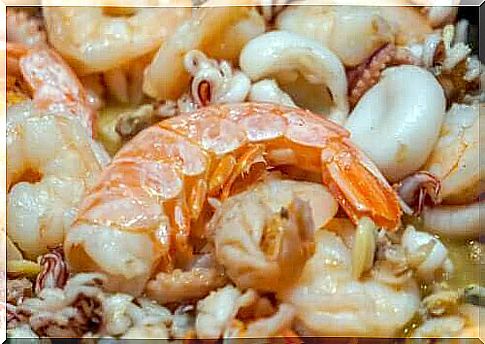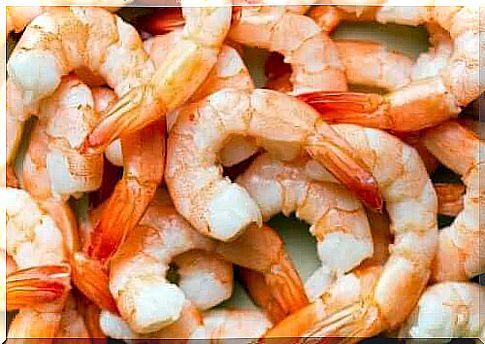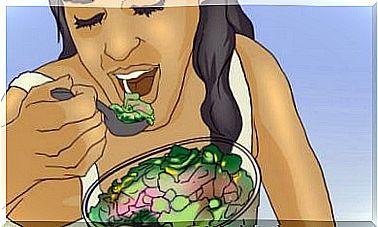The Difference Between Shrimp And Prawns
Many people mistakenly believe that shrimp and prawn are the same thing. Today’s article is about their differences and how each of them affects your recipes and their nutritional value.

Many people believe that shrimp and prawns are the same thing. In England and Australia, both are actually known as “prawns”. But despite their similarities, there are also some differences.
Both animals have a short life cycle and, as adults, form flocks. This makes them easy prey for commercial shrimp fishing. The similarities lie in their biological origin. The biologist Marcelo Scelzo assigns them both to the decapods (Decapoda) because they have a tough exoskeleton and ten legs.
There are some differences in their body, habitat, reproduction, and taste. So what exactly are these differences? Read on to find out.
Shrimp and prawns are biologically different
Both crustaceans belong to the same family, but their body structures are different. According to Charles HJM Fransen and Sammy De Grave, shrimp belong to the suborder Dendrobranchiata because they have branched gills. Three of her five pairs of legs have claws. Shrimps from the suborder Pleocyemata have lamellar gills and claws on only two pairs of their front legs.
To find more differences, look at their antennae and bowl. For example, shrimp have strong and long antennae that can triple their size. Also, if you look at the shell, you will notice that the individual areas on the stomach overlap. The second part of the shell overlaps with the first and third part of shrimp.
Shrimps usually use their legs to hatch their eggs, to which they remain attached until they finally hatch and become part of the plankton. Some species of shrimp are born males and develop into females over the course of their lives. In contrast, shrimp reproduce by mating with others and then releasing the fertilized eggs into the water.

The habitats of shrimp and prawns
Shrimp live on the bottom of the seas and oceans all over the world. They need oxygen and therefore prefer shallow waters. They are found within rocky areas in tropical and temperate waters, on the lake bed surrounded by reefs, mud, shore sand and seaweeds in salty and fresh lagoons. But they can also be found in other flowing and standing waters as well as in caves or crevices.
They move in groups through the sea and are very resistant to any temperature fluctuations. This enables them to inhabit many places across the planet.
Most shrimp live exclusively in the sea. The most widely fished species are the Penaeidae, which inhabit shallow coastal waters. Other species burrow into the seabed during the day and emerge at night to feed.
Shrimp larvae are not very resistant to low temperatures. This is probably the reason for their low distribution in higher latitudes.
Shrimp or Prawns: Which Is Bigger?
To quickly distinguish a shrimp from a shrimp, just take a look at the size: shrimp are much larger than shrimp.
They can reach 6 to 8 inches in length and are gray, while shrimp are on average between 0.95 to 2.85 inches long. In exceptional cases, however, they can even be a little larger than 3 inches and brown.
Differences in nutritional value between shrimp and prawns
At first glance, it doesn’t matter whether you eat shrimp or prawns. However, the two actually have some differences in nutritional value.
According to the Organización Panamericana de la Salud (OPS) food composition table, fresh shrimp contain around 20% protein (similar to fish, chicken or other meat). The fat content, on the other hand, is low, so they can be considered lean.
Shrimp also provide minerals like 52 milligrams of calcium and 2.4 milligrams of easy-to-absorb iron. Among the vitamins, vitamin A stands out with 54 retinol equivalents. They also contain large amounts of potassium, sodium, magnesium and zinc.
Shrimp provide only 16% of the recommended daily value in protein and less fat than shrimp. Other nutrients are also well below the value of shrimp. For example, shrimp contain 27 milligrams of calcium, one milligram of iron and 16 retinol equivalents of vitamin A. However, the potassium content in shrimp is much higher at almost 300 milligrams.
In addition, both crustaceans provide astaxanthin, one of the foods with the highest antioxidant content. This is what the reddish pigment found in shrimp and prawns is when they are cooked. Lopez Roldan also points out that this pigment has many health benefits.

Which tastes better?
From a culinary point of view, there is a slight difference in taste between both types of shellfish. Shrimp are a little sweeter than shrimp and that will undoubtedly affect the flavor of the dish you are using them with. Shrimp have a more intense taste and go well with casseroles and soups.
Shrimp go great with garlic, butter, and parsley. They also taste great in stews, with pasta or rice. As if that weren’t enough, you can grill them depending on their size. A seafood paella is sure to taste even better thanks to the intense taste of prawns.
Shrimp are firmer in texture, and their meat is harder and drier. You have to be careful not to boil it over.
Do these differences matter?
Regardless of their size, shell, habitat, or reproduction, the differences between these crustaceans affect the nutritional value of a dish. So you should eat shrimp if you want to increase your protein or iron intake. On the other hand, shrimp should be used if you want more potassium and less fat.
Opt for shrimp if you want a meal with intense flavors and choose shrimp for more balanced flavors and textures.
Enojy your meal!









